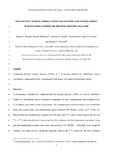JavaScript is disabled for your browser. Some features of this site may not work without it.
| dc.contributor.author | Hough, Rupert L. | - |
| dc.contributor.author | Whittaker, Martin | - |
| dc.contributor.author | Fallick, Anthony E. | - |
| dc.contributor.author | Preston, Tom | - |
| dc.contributor.author | Farmer, John G. | - |
| dc.contributor.author | Pollard, Simon J. T. | - |
| dc.date.accessioned | 2011-09-29T17:46:34Z | |
| dc.date.available | 2011-09-29T17:46:34Z | |
| dc.date.issued | 2006-10-01T00:00:00Z | - |
| dc.identifier.citation | Rupert L. Hough, Martin Whittaker, Anthony E. Fallick, Tom Preston, John G. Farmer and Simon J.T. Pollard, Identifying source correlation parameters for hydrocarbon wastes using compound-specific isotope analysis, Environmental Pollution, Volume 143, Issue 3, , October 2006, Pages 489-498. | - |
| dc.identifier.issn | 0269-7491 | - |
| dc.identifier.uri | http://dx.doi.org/10.1016/j.envpol.2005.11.043 | - |
| dc.identifier.uri | http://dspace.lib.cranfield.ac.uk/handle/1826/1186 | |
| dc.description.abstract | A preliminary evaluation of compound-specific isotope analysis (CSIA) as a novel, alternative method for identifying source correlation compounds in soils contaminated with residual heavy or weathered petroleum wastes is presented. Oil-contaminated soil microcosms were established using soil (sandy-loam, non- carbonaceous gley) amended with ballast-, crude- or No.6 fuel oil. Microcosms were periodically sampled over 256 days and δ13C values (which express the ratio of 13C to 12C) determined at each time point for five n-alkanes and the isoprenoid norpristane using gas chromatography–isotope ratio mass spectrometry (GC-IRMS). Although some temporal variation was observed, no significant temporal shifts in the δ13C values for the five n-alkanes were measured in all three oils. Isoprenoid isotope ratios (δ13C) appeared to be least affected by biotransformation, especially in the No.6 fuel oil. The research suggests that the δ13C of isoprenoids such as norpristane, may be of use as source correlation parameters. Compound-specific isotope analysis (CSIA) is a promising method for identifying source correlation compounds in soils contaminated with heavy or weathered petroleum w | en_UK |
| dc.language.iso | en_UK | - |
| dc.publisher | Elsevier Science B.V., Amsterdam. | en_UK |
| dc.subject | Stable isotopes | en_UK |
| dc.subject | Heavy oils | en_UK |
| dc.subject | Environmental diagnostics | en_UK |
| dc.subject | Contaminated land | en_UK |
| dc.title | Identifying source correlation parameters for hydrocarbon wastes using compound- specific isotope analysis. | en_UK |
| dc.type | Article | - |
Files in this item
This item appears in the following Collection(s)
-
Staff publications (SAS) [907]
